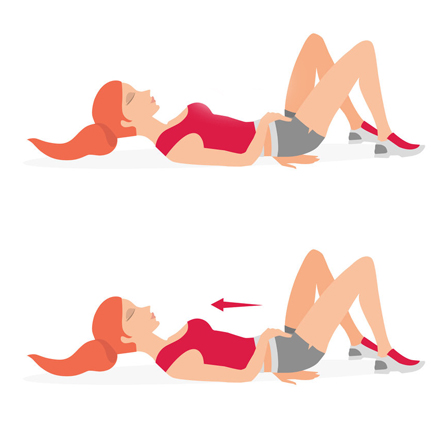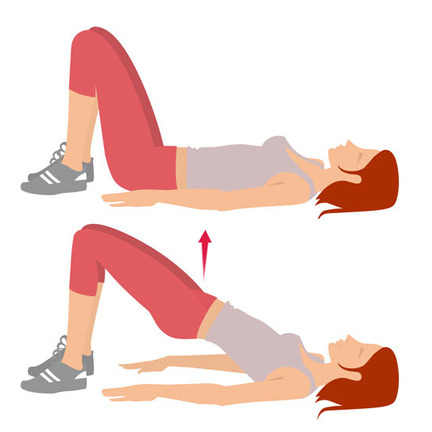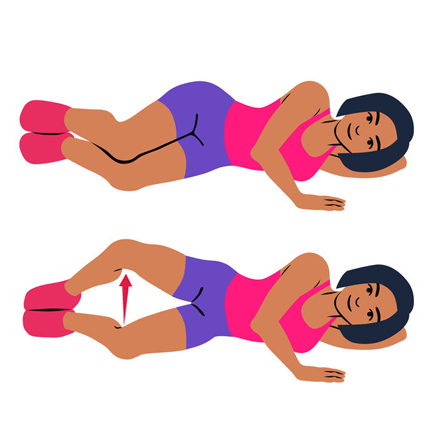Can you strengthen your pelvic floor muscles at home? Yes, yes you can!
Introduction to Pelvic Floor Rehabilitation
The pelvic floor muscles form a hammock-like structure that supports your bladder, bowel and uterus. After childbirth or as you get older, your pelvic floor muscles can become weakened. As a result, you may experience urinary or fecal incontinence, painful sex, involuntary passing of gas, and other symptoms.
In my practice as a physical therapist specializing in pelvic floor therapy, I see women every day who are experiencing these unwelcome symptoms and more. I have also seen the remarkable difference women make in their own recovery with these four simple exercises.
Why should you strengthen your pelvic floor?
When you strengthen your pelvic floor muscles, it is a proven way to treat or prevent the symptoms you might experience when the muscles are weak. In addition to aiding with incontinence, strengthening these muscles may reduce pelvic pain during sex, prevent pelvic organ prolapse, provide better support for your baby during pregnancy, and help you during childbirth.
These four exercises when done correctly have proven to be effective in strengthening the pelvic floor.
 1. Kegels (Pelvic Floor Contractions)
1. Kegels (Pelvic Floor Contractions)
This exercise can be performed in any position including sitting in a comfortable position, laying down or standing. The pelvic floor muscles form a sling from the front of your pelvic to your sacrum and coccyx and control the opening of your urethra, vagina, and rectum. Start by trying to close these openings and tighten as much as possible by pulling them up and in. Hold this for 3-5 seconds making sure you are not holding your breath. Then release the squeeze and rest 10 seconds. Repeat up to 10 reps. As these muscles get stronger over the next few days/weeks you can practice holding the squeeze longer and up to 10 seconds. This can be perform 2-4 times a day.
2. Quick flicks
Next you’ll perform a pelvic floor contraction “kegel” in a quick squeeze and release which helps build the ability of the pelvic floor muscles to respond quickly such as with a laugh, cough, or sneeze. This exercise can be performed in any position including sitting, standing or laying down. Practice squeezing your pelvic floor by closing your openings and squeeze as quick as possible and then resting for 3-5 seconds. Repeat this movement 10-20 times until you get fatigued. This can be performed 2-4 times day.
 3. Bridge
3. Bridge
Strengthening the glute muscles can also help work the pelvic floor. Lay on your back with your knees bent and spaced hip-width apart with the arms laying on sides with palms down. You’ll contract your buttock muscles and squeeze your pelvic floor at the same time and push through your heels as you slowly lift your butt into the air. Lift only as high as you can while keeping your buttocks and pelvic floor engaged. Hold this position 2-10 seconds and then slowly lower back down and relax your buttocks and pelvic floor.
Repeat this exercise up to 10 reps one time daily.
 4. Clamshell
4. Clamshell
Lay on one side with knees slightly bent. Engage your lower abdominal muscles and your pelvic floor. While keeping your feet together you will lift your top knee up only as high as comfortable without rocking your hip backwards. Hold your knee up 3-5 seconds and then slowly lower back down. Perform 10-20 reps on one side and then switch and perform with your other side.
 Want more?
Want more?
WomanWorx, Minnesota Women’s Care’s Pelvic Floor Therapy and Women’s Fitness Center, has developed programs for many kinds of pelvic floor dysfunction. Our programs contain education and exercises specific for incontinence, postpartum, pregnancy, prolapse, and pelvic pain.
Every program has been developed by our pelvic floor experts to thoughtfully take you through the healing process. Our professionally recorded videos are clear and easy to understand and can be done from the comfort of your home. Access our programs online at: www.womanworx.com.
Share this page:
About the author: Jenna Swenson, DPT
Jenna Swenson has her doctorate in Physical Therapy. During her training, she watched women go through a remarkable transformation when their pelvic floor conditions were treated successfully with physical therapy. She saw these patients experience both a physical and emotional recovery after suffering from incontinence or debilitating pelvic pain. Her focus on this specialized area of physical therapy began.
Jenna has additional training to treat women for urinary incontinence, pelvic pain, constipation, and bowel leakage. She continues to add to her knowledge with ongoing coursework and continuing education in women's health and wellness.
If you are interested in booking an appointment with Jenna for a physical therapy evaluation, call Minnesota Women's Care at 651-600-3035 or click Book Now.
